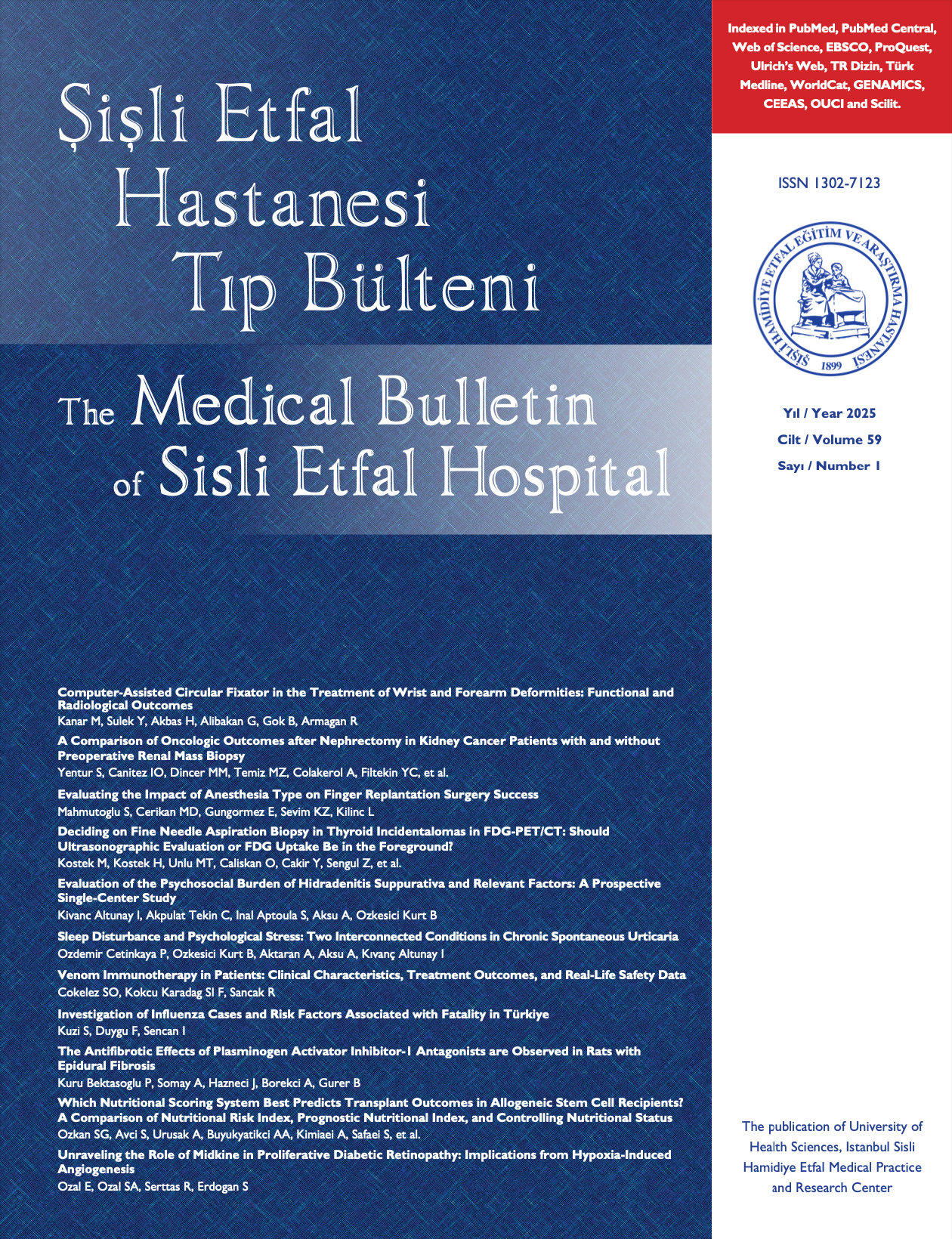
Volume: 41 Issue: 2 - 2007
| REVIEW ARTICLE | |
| 1. | Renal and ureteral trauma Erbil Ergenekon, Serdar Arısan Pages 7 - 19 Abstract | |
| ORIGINAL RESEARCH | |
| 2. | Alt üriner sistem sistem travmaları ve üretral darlıklar Mustafa Kadıhasanoğlu, Cengiz Miroğlu Pages 20 - 30 Abstract |
| 3. | The effect of topical latanoprost on retrobulbar blood flow in patients with primary open angle glaucoma and ocular hypertension Ersin Oba, Ulviye Yiğit, Fatma Koca, Burcu Dirim, Alper Özel, Muzaffer Başak Pages 31 - 35 Purpose: To investigate the effects of topical latanoprost 0,005% on retrobulbar vessel blood velocity in patients with primary open-angle glaucoma (POAG), norrnotansive glaucoma (NTG) or ocular hypertension (OH). Material and Method: Twenty patients with POAG, NTG or OH were enrolled for this study All patients were treated topically with latanoprost 0. 005 % (Xalatan). Follow-up time was three months. Each patient had a baseline color Doppler Imaging ultrasound of the central retinal artery, posterior ciliary artery, ophtalmic artery and second color doppler ultrasound examination three months later. Intraocular pressure (IOP) in each patient was also recorded with Goldman applanation tonometer before the treatment and at the end of three months follow-up. Results: Twenty patients completed the study. Topical latanoprost significiantly reduced intraocular pressure (p<0.05) The only significant change observed in the retrobulbar blood velocity with latanoprost treatment was an increase of end diastolic velocity in the posterior ciliary artery (p<0.05). No change in the other blood velocity measurements was observed with latanoprost treatment. Conclusion: Topical latanoprost significantly reduced the intraocular pressure in ocular hypertensive and glaucoma patients and didnt make unexpected changes on retrobulbar blood flow; also made an increase of end diastolic velocity in the posterior ciliary artery. |
| 4. | Minimal invasive thyroid lobectomy with lateral mini-incision tecnique: Our first experience Mehmet Uludağ, Gürkan Yetkin, Bülent Çitgez Pages 36 - 41 Background: Several reports of minimally invasive thyroid surgery using various techniques have been published. The present study reviews our first experience about thyroid lobectomy using a mini-incision with lateral approach. Study Design: The study group evaluated all patients undergoing minimally invasive thyroid surgery during the period July 2006-March 2007. Data were collected including patient demographics, indication for surgery, nodule size, final pathology, and complications. The thyroid lobectomy was carried out by 2.5-3 cm transverse incision nearly 1-1.5 cm inferior to the cricothyroid cartilage and from the medial border of the sternocleidomastoid muscle, with exposure gained by dissecting the plane between the sternomastoid muscle and the lateral edge of the strap muscles. Results: Ten patients underwent minimally invasive thyroid surgery, 9 women and a man. The average incision size that was measured at the end of the procedure was 26,4 mm. The average nodule size was 20,8 mm, and the average thyroid lobe resected was measured 54,3 mm in maximal length. Final pathology revealed benign nodules in all patients. In one of the patients edema and masseration were seen at the incision line due to the tension caused by ecartation postoperatively. In other patients complications were not seen. Conclusion: Minimal invasive thyroid surgery is a safe and feasible alternative to open thyroid surgery in "ed cases. |
| 5. | Anesthesia application in kniest dysplasia Hacer Şebnem Türk, Hale Dobrucali, Ayşe Hancı, Metin Bektaş, Ulufer Sivrikaya, Raffi Armağan Pages 42 - 44 Kniest dysplasia is an autosomal dominant hereditary disease. This disorder represents one of a spectrum of chondrodysplasias due to mutations in the gene coding for type II collagen (COL 2A1). This condition is characterized by dwarfism, enlarged joints and various skeletal abnormalities and problems with vision and hearing. During anesthesia, there are some risks related to all spine instability, cleft palate, low lung capacity. Anesthesia should not be performed before detailed evaluation of these patients. |
| 6. | Evaluation of meningococcemia cases hospitalized in pediatric infectious diseases clinic Metin Uysalol, Laliz Kadıoğlu, Umut Zubarioğlu, Ezgi Paslı, Leyla Telhan, Feyzullah Çetinkaya Pages 45 - 50 Objective: To evaluate the relation of mortality and morbidity rates with epidemiologic, clinical and laboratory features of patients with meningococcemia retrospectively. Material and Method: We reviewed epidemiologic, clinical, laboratory and prognosis of 17 patients hospitalized between january 2004 and december 2006 with meningococcemia according to hospital recordings. Results: Most patients were hospitalized in summer (%52,9). One patient from the 0-2 age group died. Ten patients had meningococcal meningitidis (%58,8), seven had meningococcemia alone. Three patients had trombocytopenia, 8 had coagulopathy. 2 of 3 patients with both trombocytopenia and coagulopathy and 2 of 3 with leukopenia (<5000/mm3) transfered to intensive care unit (1CU). All patients treatment started in first 24 hours after beginning of symptoms. Conclusion: Early diagnosis, proper antibiotic and agressive supportive therapy keep importance in meningococcemia. Suspicious cases with meningococcal disease must examined carefully and treatment start rapidly and agressively; if necessary patient transfered to 1CU. |
| 7. | Subacute thyroiditis due to brucellosis case report and review of the literature Abdulkadir Küçükbayrak, Mustafa Yıldırım, Davut Özdemir, Rezan Gergin, Ertuğrul Güçlü Pages 51 - 54 Brucellosis is a zoonotic disease that remains endemic worldwide. Brucellosis shows the involvement of many systems, however, thyroid gland involvement is rare. The diagnosis is based on clinical findings compatible with brucellosis, positive standard tube agglutination titer (>1/160 in non-endemic areas, >1/320 or >1/640 in endemic areas), and/or isolation of Brucella spp. from blood, other tissues or fluids. If the standard tube agglutination test is negative the diagnosis could be based on positive Brucella IgM antibodies and clinical findings compatible with brucellosis. This paper reports the case of a 19-year-old woman who had been followed up with the subacute thyroiditis. This case was diagnosed subacute thyroiditis due to Brucellosis as clinical findings, increased thyroid function tests and thyroglobulin antibody, positive Brucella IgM antibodies and thyroid scintigraphy. |



















